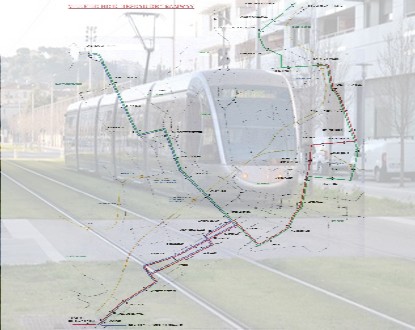The layout and execution methods of the east-west Line 2 of the tramway are taking on the shape of an American-style drama between the mayor of Nice, who is now on his fifth or sixth version, and his main opponent, Patrick Allemand, who has understood well that in a city sociologically anchored to the right, the only chance to consider winning the municipal elections in 2014 would be to create an atmosphere of referendum on a topic of general interest, and not political in the ideological sense of the term.
Far from the right/left divide, what is my preference or personal interest?
This is, roughly speaking, the sentiment present at the public presentation of the overall project by socialist officials (for the opposition, the communists were absent, as well as the Greens, who are usually allied with the socialists in the “Changing an Era” group, which had taken a side step by previously declaring both their opposition to the Estrosi project and proposing other options compared to that of the socialists).
In fact, this Dallas with a vinaigrette sauce risks derailing the project, which is already entering its fifth year of consideration after the inauguration and operation of Line 1.
According to the current version, it would only be in 2017 that this new line would be built and operational, while one would have to wait until 2019 for the project to be completely finalized.
Furthermore, for the extension to the east (Ariane – La Trinité), it will still be necessary to wait until 2030, or even longer, while the westward extension (Eco-district Méridia and Allianz Arena) is not even part of the project’s goals. Quite a calling card for an area that should become the lever for economic development and the establishment of businesses and people!
But what exactly does Patrick Allemand reproach the mayor of Nice for?
“On March 13th, Christian Estrosi announced a new turnaround in the endless drama of the tramway Line 2 by postponing its service until 2019 to Quai Cassini.
After a period of work with experts, the “Changing an Era” group takes its responsibilities in this debate. Together with all the socialist elected officials of the group, we have made a point of not delaying this project, which remains the priority of the people of Nice, and also to demonstrate that the Mayor of Nice was incapable of finalizing it within reasonable timeframes and costs.
We believe that the choice of the project should be decided by the people rather than by the courts. Therefore, for this democratic confrontation* to take place, it was necessary for us to be able to propose an alternative project to you. It is now completely ready.”
“The layout for the people of Nice,” says Patrick Allemand a little boastfully, accompanied by socialist officials and his staff. A great alternative project where the people of Nice are heard, a layout entirely on the surface, which will be complete sooner and will allow for the realization of an integrated and global network before 2025, with sub-lines reaching La Trinité and Nice Méridia, as well as the Allianz Arena.
In what way does the socialist project (One can see the hand of a group of experts not lacking competence) differ from the one voted by the Metropolis and currently awaiting the green light (on June 11th, the Court will deliberate regarding the appeal filed by the Collective that unites 300 citizens and several left and right elected officials across the board, whose spokesperson is Marc Concas, a general councilor)?
Of course, the most visible element is the firm and definitive “no” to the tunnel under Boulevard Victor Hugo, but another major element is the abandonment of the terminus at the Port and the transition to the Riquier station (as initially planned in a previous project).
To avoid writing a novel, which the relation of this hyper-complex project could even allow, we summarize the details of the project in synthesis:
Jean Médecin/CUM (cost 73.6 M€), CUM/Saint-Augustin (126.9 M€), CADAM branch (45.9 M€), airport branch (45.9 M€), depot (25 M€) for a total of 379.5 M€ including tax
In this project, the socialists want to integrate the creation of a section of Line 1 leaving Line 2 at Rue Barberis and joining it again at Boulevard Saint-Roch after servicing the Riquier station.
The extension of Pont-Saint Michel to La Trinité, as well as from Saint-Augustin to Stade/Méridia, has already been discussed, bringing the total cost to 742.5 M€, slightly less than Christian Estrosi’s project but with the advantage of creating an almost definitive network before reaching Cagnes sur Mer by 2025.
The socialist project certainly does not lack allure and even has the merit of going beyond simple criticism to offer a real alternative: It may or may not please, but it at least has the merit of existing.
One imagines the controversies that will take shape from this very day, and one can expect a politically heated climate over the coming weeks. In 2008, the project and construction of Line 1 cost Jacques Peyrat re-election, the former mayor asserting this in his remarks.
The dossier for Line 2 indeed seems to profile itself as a central element of the upcoming 2014 municipal campaign, and very clever indeed will be the one who can, this time, determine the price to pay for the city’s chief magistrate.


